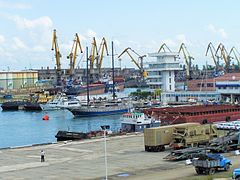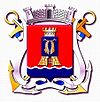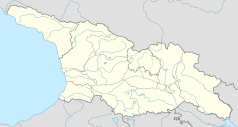Poti
 Port w Poti | |||||
| |||||
| Państwo | |||||
|---|---|---|---|---|---|
| Region | |||||
| Data założenia | VII w. p.n.e. | ||||
| Powierzchnia | 65,8 km² | ||||
| Populacja • liczba ludności |
| ||||
| Nr kierunkowy | +995 493 | ||||
| Kod pocztowy | 4400 | ||||
Położenie na mapie Megrelii i Górnej Swanetii | |||||
| Strona internetowa | |||||
Poti (gruz. ფოთი, dawniej gr. Fasis) – miasto w Gruzji, w regionie Megrelia-Górna Swanetia.
Położone jest nad Morzem Czarnym, przy ujściu rzeki Rioni, na Nizinie Kolchidzkiej. Obok Batumi, port w Poti jest najważniejszym portem morskim Gruzji.
Na wschód od miasta znajduje się Kolchidzki Park Narodowy.
W Poti znajduje się siedziba gruzińskiej Straży Przybrzeżnej.
W mieście rozwinął się przemysł maszynowy, metalowy, spożywczy oraz stoczniowy[1].
Historia
W miejscu dzisiejszego miasta, w VII wieku p.n.e. powstała grecka kolonia Fasis, która przerodziła się w miasto. Od swych początków pełniło funkcję ważnego portu nad Morzem Czarnym, gdzie krzyżowały się szlaki handlowe między Europą i Azją. Zawsze było ośrodkiem kosmopolitycznym; grecki historyk Strabon pisał, że „w Fasis są ludzie mówiący 60 językami”. Niegdyś działała tu szkoła retoryki. Miasto było wielokrotnie najeżdżane, m.in. przez Turków. W sierpniu 2008 podczas wojny w Osetii Południowej, Poti zostało zajęte przez rosyjskie wojska. W tym samym roku ustanowiono w mieście wolną strefę ekonomiczną[2].
Miasta partnerskie
Zobacz też
Przypisy
- ↑ Poti, [w:] Encyklopedia PWN [online] [dostęp 2021-08-06].
- ↑ Wybrzeże i Adżaria. W: Sławomir Adamczak: Gruzja, Armenia i Azerbejdżan. Bielsko-Biała: Wydawnictwo Pascal, 2013, s. 227, seria: Praktyczny przewodnik. ISBN 978-83-7642-141-4.
Linki zewnętrzne
Media użyte na tej stronie
The flag of Navassa Island is simply the United States flag. It does not have a "local" flag or "unofficial" flag; it is an uninhabited island. The version with a profile view was based on Flags of the World and as a fictional design has no status warranting a place on any Wiki. It was made up by a random person with no connection to the island, it has never flown on the island, and it has never received any sort of recognition or validation by any authority. The person quoted on that page has no authority to bestow a flag, "unofficial" or otherwise, on the island.
Autor: Nc tech3, Licencja: CC-BY-SA-3.0
Port of Poti, Georgia, This photo was taken about 2 weeks before the port was destroyed by Russian aircraft.
Autor: Berdo Maghularia from Kutaisi, Gerogia, Licencja: CC BY-SA 2.0
The cathedral is an imitation of Hagia Sofia in Istanbul, and it was built in 1906-07 with the great contribution of Niko Nikoladze, the mayor of Poti. Notably, Niko Nikoladze chose the location of the cathedral in the center of the town to make it viewable from every side of Poti.
A. Zelenko and M. Marfeld were the architects of this Neo-Byzantine cathedral and the capacity of the church is 2,000 people. The ornaments and decorations are taken from the medieval Christian cathedrals in the Trabzon mountains. The Poti Cathedral has three iconostases and among the main decoration of the iconostasis are the icons of St. Nino, St. Andrew the First Called, and the St. David the Builder.
In 1923, after the Red Army invasion of Georgia, the Communist government turned it into a theater and the bells were donated to the industrialization foundation.
In 2005, the cathedral was restored to the Georgian Orthodox Church.The flag of Poti.
The Poti city coat of arms from 2005
(c) Giorgi Balakhadze z projektu Wikimedia Foundation, CC BY-SA 4.0
Samegrelo-Zemo Svaneti location map
















